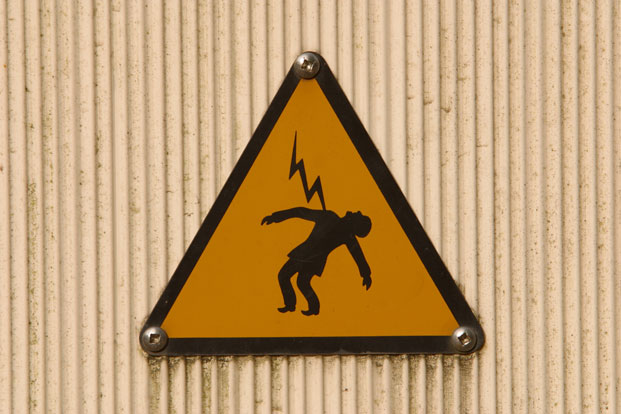The United States Consumer Product Safety Commission indicated in a 2010 report that 17 percent of consumer product electrocutions were results of amateur repair attempts on small appliances. Needless to say, the devices were not unplugged before the attempts to fix them.
There are many potential dangers from electricity in the average household. From lighting fixtures to broken appliances, wall outlets to power cords, electrical boxes to hidden wires, your house surges with electricity. That’s why it’s important to have an enormous amount of caution when dealing with anything electrical. If you make a mistake, it can cause serious injury or death. Children can die from voltages that are less than 500, while adults are slightly higher than that range. But no matter what the household amperage, avoiding the consequences of playing with electricity is imperative.
Most accidents occur when someone makes contact with faulty appliances or touches frayed or damaged wiring; are caught by electric arcs from high-voltage lines; are injured by machinery; or, in the case of curious children, are hurt by biting or chewing live electric wires or fiddling with wall outlets, usually inserting a metal object into them.
The body is made up of a large amount of water, so it’s a great conductor of electricity, making direct contact with any source of electricity potentially deadly. Even minor burns, which can appear harmless, may not tell the whole story because internal injuries often occur from exposure to electricity. The injury’s severity is determined by a number of factors, including the type of voltage (AC or DC), its strength, how it moves through the body and the victim’s health.
Electric current injures the body in one of three ways: Cardiac arrest from the shock to the system; destroying critical nerves, muscles and tissues from a jolt of electricity; or sustaining severe thermal burns from a power sources. This can result in being knocked unconscious, suffering a heart attack, sustaining a broken bone, getting a severe headache, heart arrhythmia, blurry vision, lost hearing or swallowing problems. Victims may experience muscle spasms, severe pain, breathing problems, lung failure, general numbness or tingling, and in extreme cases, seizures.
First Aid
Because electrocution injuries are potentially devastating and life-threatening, call 911 and get medical professionals to the scene as soon as possible.
Before administering any aid or comfort, ensure that the electric current is off. Electricity that’s running loose can affect people from 10 to 20 feet away. Don’t touch the victim directly if he or she is still in proximity to the source of the electric current — the power may conduct into others. Find the house circuit breaker if at home or use something that is non-conductive – a wood broom, rug, chair or rubber doormat – to push the person away from the electric current source. Whatever you do, don’t use something wet or made of metal. If possible, ground yourself by standing on a rubber mat or newspapers before touching someone. Because electricity is invisible, and the victim may be unconscious, it’s often impossible to tell if nearby areas are safe.
Once the victim is away from the source of the electric current that caused the problem, make sure they are breathing. It may be time to do mouth-to-mouth resuscitation if you don’t detect any breathing. If someone has been burned, rinse the burn with cold running water and remove clothing in the affected area.
What to Do – and What Not to Do
Do not apply ice, ointment, dressings or bandages to the burned area. Their removal may irritate the area and slow help once medical professionals arrive. Avoid removing any dead skin or breaking up blisters. This is not a job for witnesses who don’t know what they’re doing at the scene.
Burns are usually most apparent at the point where the electrical source was touched. Look at the heels, hands or head. In children, the mouth or lip may be burned from biting or chewing the electricity source. The affected areas will have a red or dark appearance.
If the victim appears to be in shock, make him or her comfortable. Shock is apparent in shallow breathing, paleness and a low pulse rate. Lay the victim down, lower the head below the trunk, and keep warm with a coat or blanket.
If the person was the victim of an explosion, serious internal injuries akin to a car crash may have resulted because he or she may have been thrown away from the blast and landed on hard ground. Be careful moving these victims, particularly the head or neck area — this may cause paralysis if there’s a spine injury.
If your victim is pregnant and sustains a shock, it’s wise to seek professional medical attention, no matter the level of injuries. In other cases, burns that are not healing or appear to expand need to be observed by a medical professional. This is particularly true if there was a period where the victim was unconscious from electrical contact.
At the Hospital
The medical team at a hospital will try to determine if internal injuries are present. To do this, they may administer an EKG to check the heart and take a blood count and urine sample to determine muscle enzymes, a sign of muscular injury. If the person has significant pain in certain areas, medical personnel may perform an X-ray or CT scan to look for fractures or dislocations.
If the electric accident victim appears in relatively good shape, you can deal with the injuries at home. Burns can be treated with ointment and bandages when a medical professional advises it.
Obviously, it’s best to avoid any potential for trouble by teaching young children about the dangers of electricity. Child-proof guards on wall outlets are a good way to stop accidents before they happen. As for adult injuries, caution is the watchword. Always check for frayed or damaged wires and use extreme caution when handling anything that conducts electricity.

Leave a Reply